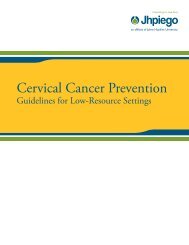Manual for Male Circumcision under Local Anaesthesia
Manual for Male Circumcision under Local Anaesthesia
Manual for Male Circumcision under Local Anaesthesia
You also want an ePaper? Increase the reach of your titles
YUMPU automatically turns print PDFs into web optimized ePapers that Google loves.
<strong>Male</strong> circumcision <strong>under</strong> local anaesthesia<br />
Version 3.1 (Dec09)<br />
immediately after caring <strong>for</strong> a patient. Gloves should not be used <strong>for</strong> the care<br />
of more than one patient.<br />
Change or remove gloves in the following situations: during patient care if<br />
moving from a contaminated body site to a clean body site within the same<br />
patient; after patient contact be<strong>for</strong>e touching another patient.<br />
In countries with a high prevalence of hepatitis B, hepatitis C and HIV<br />
infection, wearing two pairs of gloves (double gloving) may be appropriate <strong>for</strong><br />
surgical procedures lasting more than 30 minutes or involving contact with<br />
large amounts of blood or body fluids. This situation is not likely to apply with<br />
properly screened patients <strong>under</strong>going clinic-based circumcision.<br />
Table 8.1 Gloving requirements <strong>for</strong> common tasks in a male circumcision<br />
service<br />
Activity<br />
Checking blood pressure or temperature, giving an<br />
injection<br />
Drawing blood and testing <strong>for</strong> HIV<br />
Handling and cleaning instruments, handling<br />
contaminated waste, cleaning spills of blood or other<br />
body fluid<br />
Surgery<br />
Type of gloves<br />
No gloves required<br />
Examination<br />
Utility<br />
Sterile surgical<br />
Keep in mind the following:<br />
• Wear gloves of the correct size, particularly <strong>for</strong> surgery.<br />
• Use water-soluble (non-fat-containing) hand lotions and moisturizers, to<br />
prevent skin from drying, cracking, and chapping. Avoid oil-based hand<br />
lotions and creams, because they can damage latex rubber surgical and<br />
examination gloves.<br />
• Keep fingernails short: they should not extend beyond the fingertip.<br />
Bacteria and other microorganisms that cause disease can collect <strong>under</strong><br />
long nails. Long nails also tend to puncture gloves more easily.<br />
• Store gloves in an area where they are protected from extremes of<br />
temperature.<br />
• Glove reprocessing is strongly discouraged and should be avoided. There<br />
is currently no standardized, validated and af<strong>for</strong>dable procedure <strong>for</strong><br />
reprocessing gloves.<br />
• Using gloves when they are not necessary represents a waste of<br />
resources.<br />
Masks, caps and protective eyewear<br />
Masks protect the mucous membranes of the mouth and nose from possible<br />
infections, as well as reduce the risks of transmission of infections from the<br />
health care worker. They should be worn by anyone <strong>under</strong>taking a procedure<br />
Prevention of Infection Chapter 8-8
















